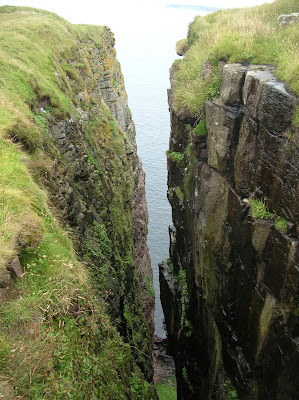Handa Island is owned by Dr Jean Balfour but it has been managed by the Scottish Wildlife Trust since 1991. Between 1961 and 1991 it was managed by the RSPB and it is best known for its seabird colonies. Nearly 100,000 seabirds nest on the island each year. However by the time I visited at the beginning of September there were only fulmars and skuas and a few gulls to be seen. However the cliffs themselves are stunning in their own right.
Handa Island is accessible by a passenger ferry from the hamlet of Tarbet from the end of March to the end of August. The narrow road to Tarbet meets the A894 about halfway between Scourie and Laxford Bridge. When I visited in 2011 the charge was £10 for adults and £5 for children. Dogs are not allowed on the island and there are no toilets.
Geologically Handa is composed of Torridonian sandstone. This has weathered to leave horizontal ledges, which are ideal if you are a seabird looking for somewhere to nest.
Ruined Cottage
Until 1848 when the potato crop failed 60 people in 8 families lived on Handa in stone cottages in the SE of the island. They grew oats and potatoes, kept animals and collected seabirds and their eggs and shellfish from the beaches. By 1851 they had all left, mainly emigrating to America.
The remains of a graveyard can be seen in the SE of the island outside the information hut. It was probably used to bury people from the mainland at a time when wolves were still roaming wild.
Great Stack
Boardwalk across the island
This is the longest boardwalk I have ever seen. Most of the path from the old village to the north coast and along the south coast is boardwalk across the heather covered boggy ground both to protect the fragile environment and to prevent visitors from getting very wet feet!
Cliffs at Puffin Bay
The cliffs on the north coast are about 85 metres high. The highest point on the island is Sithean Mor at 123 metres. In the breeding season there are thousands of guillemots, razorbills, kittiwakes and puffins to be seen. The whole island is an SSSI.
Rats were a problem to ground nesting birds like puffins but they were eradicated from the island in 1997.
Almost vertical cliffs
Narrow geo
Another geo
Blowhole- Poll Glup
Looking towards Great Stack
Port an Eilein
Ferry to Handa - at Traigh an Teampull
Looking towards Traigh an Teampull
Traigh an Teampull - landing beach
Information Hut
Port an Eilein
Meall a Bhodha

























